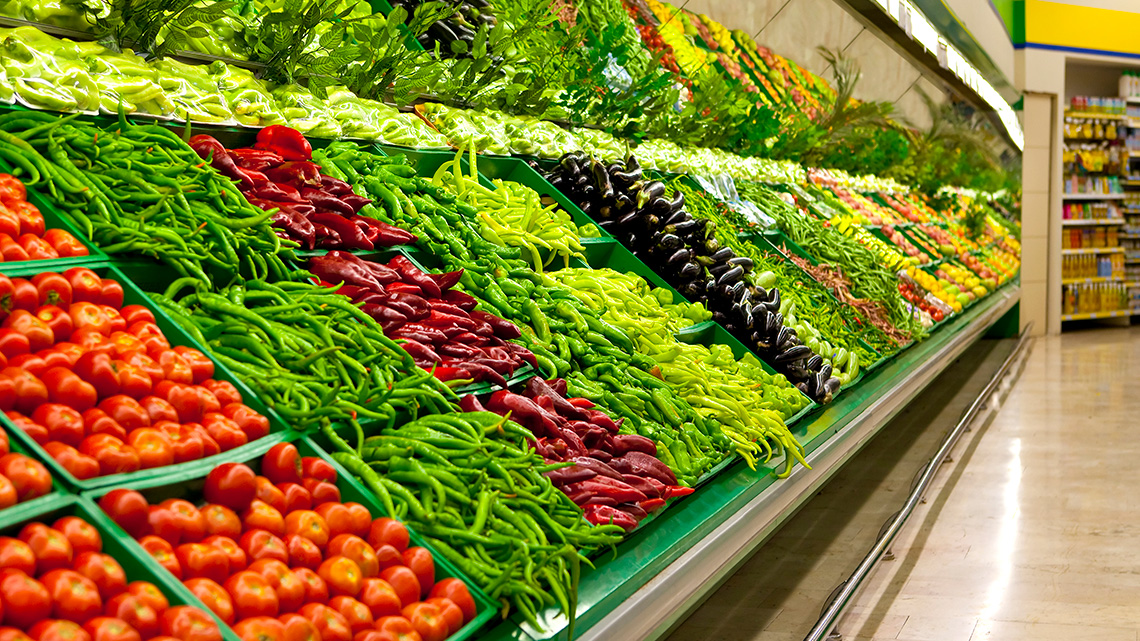Minds On
What do you value?

A business owner must pay a contractor for renovations completed on their store. They can choose either Option 1, using money to pay, or alternatively they can select Option 2, trading goods available in the store as a form of payment to the contractor.
Option 1: $800
Option 2: pants, shoes, hats, and jackets (equivalent to $800)
Which option did you choose? Why?
Record your answer in a format of your choice.
In this learning activity, you will learn about money as a method of measuring value and cash as a form of payment for goods and services.
Action
Thinking about food
We are talking about food today and working with money as a method of measuring value. Explore the following video, “Where Does Food Come From?” to learn about how we make different types of food.
What new learning happened for you? Record your response and share, if possible.
The friendly number ten at the grocery store
Pretend that you are at the grocery store. Examine the following list of ten items.
| Item | Price ($) |
|---|---|
| Egg salad sandwich combo | $10 |
| Soup | $6 |
| Scone | $3 |
| Apple juice | $2 |
| Cucumber | $3 |
| Bread | $1 |
| Blueberry jam | $4 |
| Honey | $5 |
| Croutons | $5 |
| Crackers | $4 |
How can you estimate, using mental math, the cost of purchasing these ten items?
We can group the prices that add up to ten, as this is considered a friendly number that is easier to add.

To find prices that can add up to ten, we explore the combinations of numbers from the list that add to ten:
5 + 5
6 + 4
7 + 3
8 + 2
9 + 1
We scan our items, and notice that the price of an egg salad sandwich is already $10.
Next, we scan and notice that the cost of honey and croutons are each $5.
So, two groups of $5 or $5 + $5 equals $10.
Next, we notice that the price of soup is $6, the bread is $1, and the cost of scone is $3. Together, these three items add to $10.
Lastly, we notice the apple juice is $2 plus the blueberry jam is $4. The crackers are also $4. This gives us another group of $10.
Altogether, we made 4 groups of $10, which is also stated as:
4 x 10 = $40.
The following chart lists the 4 different groupings that were mentioned above.
| Item(s) | Group | Total price ($) |
|---|---|---|
| $10 egg salad combo | 1 group of | $10 |
|
$5 croutons $5 honey |
1 group of | $10 |
|
$6 soup $3 scone $1 bread |
1 group of | $10 |
|
$4 blueberry jam $2 apple juice $4 crackers |
1 group of | $10 |
There are other ways to arrive at the same answer.
Rearrange the prices of items to groups of $10 in a different way than this example. Record your thoughts using a method of your choice.
Can you find a third way to group the prices of these items into $10?
Five as a friendly number
Another way to quickly add items using mental math is to group the items into $5 amounts. The number five is also considered a friendly number.
Numbers that add up to five are:
1 + 4
2 + 3
Which item prices from the list, when combined together, add up to $5? Record your answers using a method of your choice.
| Item | Price ($) |
|---|---|
| Egg salad sandwich combo | $10 |
| Soup | $6 |
| Scone | $3 |
| Apple juice | $2 |
| Cucumber | $3 |
| Bread | $1 |
| Blueberry jam | $4 |
| Honey | $5 |
| Croutons | $5 |
| Crackers | $4 |
Which did you find easier as a number for using mental math? 5 or 10?
Consolidation
Let’s go grocery shopping!
Examine the list of items Zoey mentioned in the TVO video, “Where Does Food Come From?” from the Action section.

Select at least 10 items to purchase from the following list. Using the prices provided and mental math, estimate and record how much you think the number of items you select will cost all together.
Record your estimates using a method of your choice.
| Item | Price ($) |
|---|---|
| Blueberries | $4 |
| Mushrooms | $3 |
| Artichokes | $4 |
| Vinegar | $4 |
| Apples | $5 |
| Tofu | $3 |
| Peppers | $5 |
| Carrots | $6 |
| Celery | $6 |
| Cucumbers | $3 |
| Garlic | $2 |
| Onions | $5 |
| Salt | $3 |
| Ketchup | $4 |
| Tomatoes | $6 |
| Bread | $8 |
| Mayonnaise | $3 |
| Brown eggs | $4 |
| Spaghetti | $3 |
| Chocolate | $4 |
| Beans | $1 |
| Corn | $5 |
| Pop | $3 |
| Juice | $5 |
| Flour | $6 |
| French fries | $8 |
| Cheese | $5 |
| Maple syrup | $9 |
| Sugar | $4 |
| Butter | $4 |
| Cinnamon | $4 |
| Popcorn | $5 |
| Egg salad sandwich | $10 |
| Tomatoes | $6 |
| Lettuce | $3 |
| Chips | $4 |
| Doughnuts | $2 |
| Sunflower butter | $5 |
Explain the strategy you used. Calculate the actual cost of the items you chose.
Compare this answer to the estimated total you found using mental math.
Reflection
As you read through these descriptions, which sentence best describes how you are feeling about your understanding of this learning activity? Press the button that is beside this sentence.
I feel...
Now, record your ideas using a voice recorder, speech-to-text, or writing tool.
Press ‘Discover More’ to extend your skills.
Discover MoreActivity 1
Independently, ponder this quote from Chief Seattle, who was a Suquamish and Duwamish chief who lived from 1786 – June 7, 1866 (the American city Seattle in Washington, U.S.A. is named after him).
“Only when the last tree has died and the last river has been poisoned and the last fish has been caught will we realise that we can not eat money.”
— Chief Seattle
Recall the Minds On scenario from the start of this learning activity. In that situation, a store owner could pay a contractor with either Option 1 ($800.00) or Option 2 (goods from their store). In that situation, Option 1 was the better choice. Part of Chief Seattle’s quote says that we cannot eat money. Do you think there are some things in your life that no amount of money cannot replace? Explain your answer, and then, if possible, share and discuss your thoughts with a partner.
Activity 2
Find an online flyer and/or search a grocery store website for the prices of at least 10 of the items on the following fillable and printable list Grocery Store Prices. Do a price comparison between the prices on the list and the prices you found online. A third column is provided on the Grocery Store Prices document for your price comparison. Alternatively, you can record the items and prices in your notebook.
Next, use the whole dollar amounts for the prices you found listed online and use mental math to estimate the total. Explain your strategy. Next time you are in a grocery store, practice using the whole dollar amounts of prices for five – ten items to estimate their costs.

Press the ‘Activity’ button to access the Grocery Store Prices.
Connect with a TVO Mathify tutor
Think of TVO Mathify as your own personalized math coach, here to support your learning at home. Press ‘TVO Mathify’ to connect with an Ontario Certified Teacher math tutor of your choice. You will need a TVO Mathify login to access this resource.
TVO Mathify (Opens in a new tab)